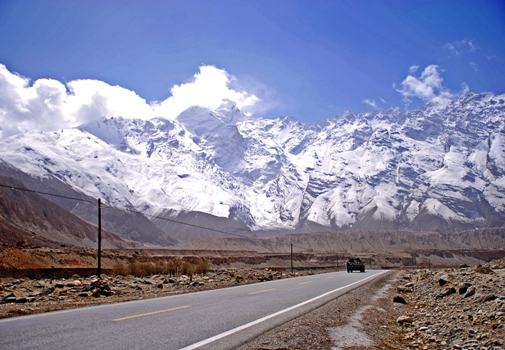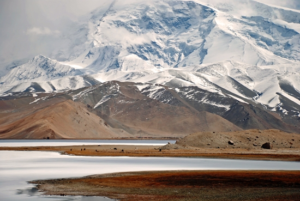 I arrived in Kashgar after a nearly three-day trip from DC with a layover and shower in Urumqi lasting only a few hours. I was met at the airport by a couple of wonderful Uyghur guys from Kashgar Guide/Xinjiang Travel who whisked me straight out of the city and onto the Karakorum Highway for a bit of adventure. Dust swirled as we sped southwest on the highway past blooming apricot trees and swaths of wheat sprouting bright green amid the sand and clay. We stopped in Opal to buy food for a picnic and found fresh naan and lamb kebabs as well as a gorgeous selection of fresh fruit. We packed it all up for a lunch at Karakol Lake and started out again. We continued for a way on the dusty plain, but soon the mountains were looming up on the left. They rose higher and higher until they formed a massive snow-capped wall in front of us.
I arrived in Kashgar after a nearly three-day trip from DC with a layover and shower in Urumqi lasting only a few hours. I was met at the airport by a couple of wonderful Uyghur guys from Kashgar Guide/Xinjiang Travel who whisked me straight out of the city and onto the Karakorum Highway for a bit of adventure. Dust swirled as we sped southwest on the highway past blooming apricot trees and swaths of wheat sprouting bright green amid the sand and clay. We stopped in Opal to buy food for a picnic and found fresh naan and lamb kebabs as well as a gorgeous selection of fresh fruit. We packed it all up for a lunch at Karakol Lake and started out again. We continued for a way on the dusty plain, but soon the mountains were looming up on the left. They rose higher and higher until they formed a massive snow-capped wall in front of us.
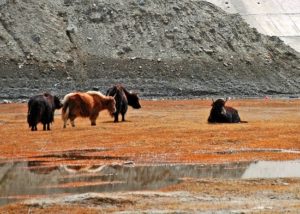 As we began to make our way through the Karakorum Range through the Ghez River Valley, the mountains rose higher and higher until some of the peaks topped 8000 meters in height. The land around me was like a living geological textbook – with some of the best examples of uplift and water erosion I’ve ever seen. The strata in most cases can be read like a book. It is not a fertile place. It is dry and forbidding this time of the year. Many of the lakes and streams were low or dry, but I was told that was because the snows on the mountaintops hadn’t melted yet. Then water is plentiful and the plains flood and the rivers roar with clean water from on high. Everywhere, domesticated yaks and camels graze freely on the sparse dried vegetation they can find amongst the dry rocks and gravel.
As we began to make our way through the Karakorum Range through the Ghez River Valley, the mountains rose higher and higher until some of the peaks topped 8000 meters in height. The land around me was like a living geological textbook – with some of the best examples of uplift and water erosion I’ve ever seen. The strata in most cases can be read like a book. It is not a fertile place. It is dry and forbidding this time of the year. Many of the lakes and streams were low or dry, but I was told that was because the snows on the mountaintops hadn’t melted yet. Then water is plentiful and the plains flood and the rivers roar with clean water from on high. Everywhere, domesticated yaks and camels graze freely on the sparse dried vegetation they can find amongst the dry rocks and gravel.
We were told by some Tajik herdsmen that in this area they only make Yak dairy in September and October because the pasture is so poor before the melted snow comes. They leave the milk for the young at this difficult time until the young yak are fully able to graze on their own.
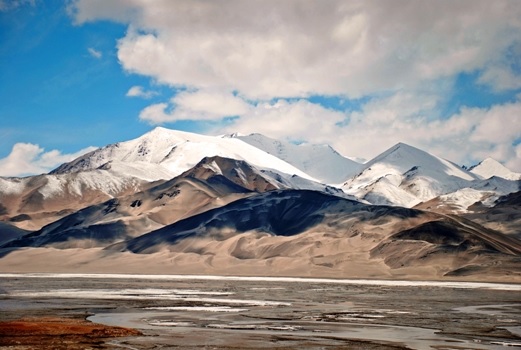
After we left the Ghez Valley the road turned south again and continued to rise in altitude. As we left the mountains we entered into a valley of some of the most splendidly desolate scenery I have ever seen. The Pamir foothills rose on the right. Great cloud banks moved over head casting deep shadows over the land below and my head was full of Steve Reich marimbas and the whistle of cool Spring wind.
We met a mixed group of Tajik and Kyrgyz traders camped by the roadside selling amber goods ranging from necklaces to scorpions embedded in the hardened sap. The tall Kyrgyz trader haltingly told me in English that he would give me the hat off his head – so I bought it. I saw him on the return journey with a new hat, so apparently that is part of his sales routine. So many hats so few tourists.
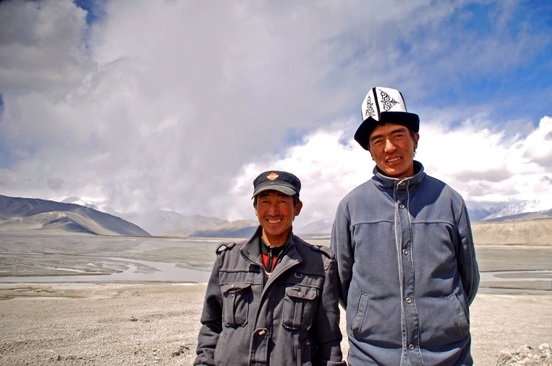
We finally stopped for lunch at Karakol Lake and dined on the naan and kebabs as well as the sweetest small oranges I’ve ever had, and fantastic local pears. The fat from the lamb flavored the naan perfectly and the pears were crisp and sweet and juicy with firm texture and would, I think, make good cooking pears.
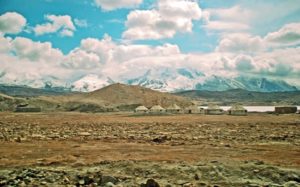
Tashkorgan gets its name from the ancient Stone Fortress on the outskirts of the city. The ruined fort, which is the ancient capital of the Tajik people, was inhabited more than 2000 years ago as part of the kingdom of Puli.
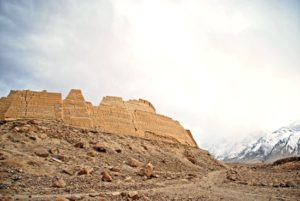
We walked around the modern city first and came upon a small market on a side street. They had the most delicious looking roasted chickens coated with chili peppers and sesame seeds – spicy and earthy at the same time. I bought several different types of chilies – each one more powerful than the next. The kids were everywhere and unlike in the States, they roamed freely through the streets. They are gorgeous and looked like they could be from anywhere in the northern hemisphere – other than China and Eastern Asia.
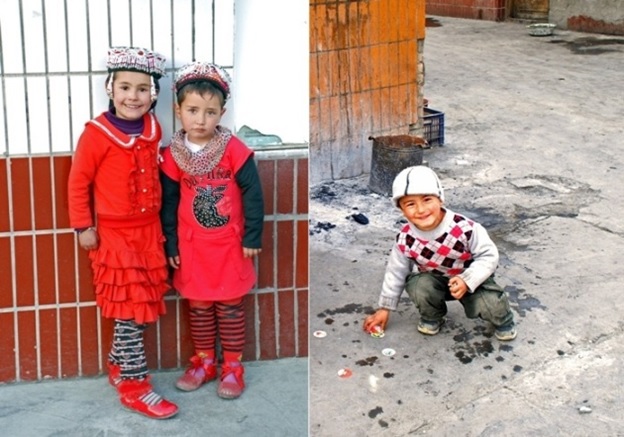
My guide, Hasan, and I climbed up to the great fortress and sat on top overlooking the deserted plain below. The fort is surrounded on three sides by mountains and opens on the east to the Taklamakan desert. Turning away from the modern city which lay nearby, the rest of the landscape is today exactly as it was when the Stone Fortress was bustling with life and love and trade. Ancient ammunition still littered the ground. Now and again we spied a perfectly rounded stone a bit larger than the rest that was used with a slingshot in defense of the realm. We sat for a long time as the sun started to fade. The silence was broken only by the tittering of an eagle in the distance like an echo

